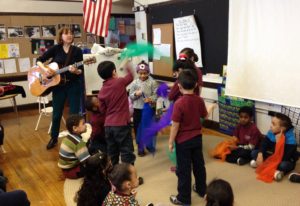I recently watched a video about arts integration at the Two Rivers Charter School in Washington, D.C. Second graders created giant Jackson Pollock-style paintings while learning about the physics of flight; fourth graders learned about their local rivers by enacting the history of a river through poetry, movement and drama.
By the way, the school’s test scores were impressive, too. That shouldn’t matter, but in a world where it does matter, it’s worth noting that teaching through the arts can make a difference in student achievement.
What is arts integration? The Kennedy Center ArtsEdge defines arts integration as follows:
Arts Integration is
an APPROACH to TEACHING
in which students construct and demonstrate
UNDERSTANDING
through an ART FORM.
Students engage in a
CREATIVE PROCESS which
CONNECTS an art form and another subject area
and meets EVOLVING OBJECTIVES in both.
Source: “Defining Arts Integration” by Lynne B. Silverstein and Sean Layne © 2010, The John F. Kennedy Center for the Performing Arts (emphasis and text position are consistent with the article’s presentation).
Since my time a decade ago at Lesley University studying creative arts in learning, I’ve seen the effectiveness of arts in the classroom many times through my residencies with Young Audiences of Massachusetts and VSA/MA. Through music and movement, I’ve seen kids developing new insights on everything from classic stories to life sciences, whether it’s acting out the Three Little Pigs to music or dancing out the life cycle of a butterfly.
The arts provide a language that reaches deeper than words, engaging multiple parts of the brain. In the textbook for the Wheelock College class I’m teaching this semester, I came across the authors’ reasoning for including students with special needs in mainstream music classes. Not surprisingly, their reasoning also provided an excellent justification for arts integration (especially music):
–Music taps into nonverbal ways of knowing and allows children to express ideas regardless of verbal abilities.
–Music, as a performing art, allows for the expression of a wide range of emotions, and it can communicate on very deep level without the use of words
–Music is multimodal in nature, stimulating the eyes, ears and muscles along with the mind … The joy of producing sounds and movements draws children actively into the process of music making instead of requiring them to be passive receptors of new ideas.
–Music making is generally a collaborative endeavor. Music is usually made and learned in groups, not alone … children gain a sense of belonging and commitment to a group, which is important to social development.
–A single activity in a music classroom (or a music activity in a general classroom) can be adapted to a wide range of ability levels.
–Music, as a temporal art, challenges the mind to recognize patterns across time.
Source: Music in Childhood, From Preschool Through the Elementary Grades, Fourth Edition; Patricia Shehan Campbell & Carol Scott-Kassner. Schirmer Cengage Learning. 2014 (pp.408-409).
In my college class, I decided to demonstrate arts integration with two activities. The first one helps children learn about empathy, as well as the water cycle. The activity uses the song, “Canciòn de la Nube” (Song of the Cloud), featured in Sarah Pirtle’s 1998 book, Linking Up! You can see my version of this song at this link.
Based on a poem by Adrian Ramirez Flores of Guatemala, this short song tells the story of a sad little cloud. The cloud is sad because a flower down on the ground is dying because it has no water. The cloud summons the wind, and together they go to the river, so that the cloud can “drink” some extra water and give the flower some rain. In the end, the cloud smiles down happily on a revived flower.
My students acted out this story out with movement and scarves. Pirtle suggests additional art activities and partner movement in which one person plays the flower and the other the cloud.
This song is a way to start a discussion with students about what empathy is and how we can act on it. It’s an excellent tool for enhancing language learning with a song in both English and Spanish, as well as teaching about the water cycle.
You can find Linking Up! and other books on Sarah Pirtle’s web page. This book was published almost 20 years ago but remains more relevant than ever in today’s world.
True arts integration requires not only that art forms be present in the classroom, but that students be active in the creation of art. This is important because students only truly deepen their understanding when they are active participants. As Louise Pascale and Lisa Donovan point out in their 2004 book, Integrating the Arts Across Content Areas:
“The arts provide opportunities for students to move between different representations of content. For students to create arts-based work, they must translate their understanding of content into new forms. They cannot translate without understanding. In order to move between languages and symbol systems to create new representations, students must draw upon higher-order critical thinking skills such as analysis and evaluation, leading to artistic creation.” (p.18).
I’ll give a full summary of another arts integration activity in my next post.






An engaging and thoughtfully written post, Liz. Thank you for your good work.
Thank you, Brigid, for taking the time to comment! I look forward to seeing you soon!
This is great Liz! And I was looking for info on the importance of Arts and Music in the classroom for the school I teach at. Thanks!
Liz what a great post. I have Sarah’s book, I’ll have to go revisit it. Love these examples.